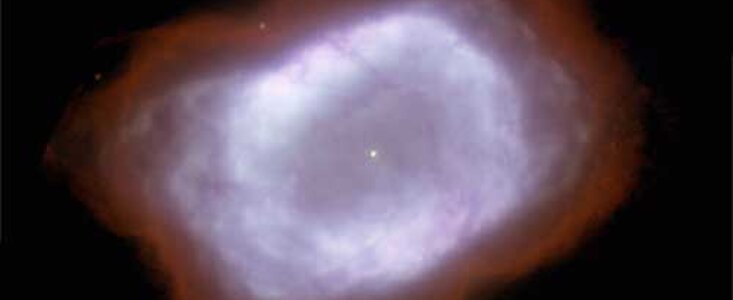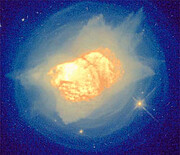Peering into the Sun’s Future with Gemini North
5 January 2009
The newest addition to the Gemini Legacy imaging program is a laser-guide-star enabled near-infrared image of the well-known planetary nebula NGC 7027 (Figure 1). NGC 7027 lies at a distance of about 3,000 light-years from Earth and is located in the direction of the constellation Cygnus. The nebula itself is approximately 14,000 astronomical units from end-to-end, about 140 times larger than our Solar System.
NGC 7027 is a planetary nebula, so-named because early observers with small telescopes thought that these targets resembled fuzzy ‘planets’ in the sky. We now know that objects like NGC 7027 are not planets, but the name has stuck throughout the years. We also know that objects like NGC 7027 give us a tantalizing peek into the future of our own Sun.
Toward the end of their lives, when they get close to exhausting all of the nuclear fuel they are born with, stars like the Sun expand greatly in size by slowly ‘puffing up’. In fact, when the Sun enters in this phase and turns into something called a ‘red giant’ it will be so large that its outer layers will almost reach the orbit of the Earth. After they expand like this stars start to shed the top parts of their greatly expanded atmospheres. As they shed this material, the central part of the star starts getting hotter which in turn heats up the material that was shed, causing it to glow brightly. This is the glow that we are seeing from NGC 7027 in our new image, the glow from the material that the star shed as it became a red giant. Superimposed over the glowing gas we see as the purple/white and red colors in the image, we can also see dark lanes of dust that condensed within the material as it was thrown off of the star. The central star of the NGC 7027 system is shining brightly as the white point in the center of the picture. In fact, two of the reasons that NGC 7027 is classified as a planetary nebula are that its central star has a measured temperature in excess of 100,000 K and there is strong [O III] emission seen in its optical spectrum.
The new Gemini data compares well with optical observations of NGC 7027 made by the Hubble Space Telescope (Figure 2). In the HST image we are seeing emission from the very hot gas that has recently been shrugged off of the central star. One feature that is present in both images is the dark dust lane that cuts across the center of the system. The dust appears “dark” in both images as it is blocking some of the light that is being emitted by material that lies behind the dust grains.
This Gemini image represents some of the first adaptive-optics observations ever made of NGC 7027. Our imaging was enabled by the use of our Laser-Guide-Star system which allowed the telescope to guide on the faint optical emission from the central white dwarf star. We used the Gemini facility adaptive-optics system Altair in conjunction with the near-infrared imager NIRI to obtain these data. The image presented is the combination of data taken in two filters [Fe II] and H2 (S 1-0). The [Fe II] emission is coded in the white color; the molecular hydrogen (H2) data is colored red.
Interestingly, this is not the first time NGC 7027 has been observed with Gemini North. As seen in Figure 3 this famous planetary has also been observed in the thermal-infrared with the Gemini facility instrument MICHELLE. In the MICHELLE data presented here we are seeing emission from dust grains that are heated by the central star to temperatures of approximately 300 K. On the broadest scale these images are similar to previous mid-infrared observations of the source.
That is, they show that the dust in NGC 7027 is distributed in a ring-like structure in the outer regions of the nebula. However, the high angular resolution offered by MICHELLE and Gemini has revealed small-scale structure in the dust distribution, particularly in the 7.9-micron image (Figure 3 - left). The images show that the dust ring is 'broken' in both the northwest and southeast, directly along the axis of the two outflows known to originate from the central star. In these images, we can see that the outflows are 'punching through' the dust shell and re-distributing the grains along their paths.
NGC 7027 is a favorite target for amateur astronomers since it is a bright and compact nebula. Shining at magnitude 8.5, NGC 7027 is a treat even in 4 – 6 inch telescopes. It has been reported that from a dark site with decent seeing the object looks like ‘a swollen star’ at 23x with a 4” refractor. At higher magnifications (> 200x or so) the object is seen as an elongated ‘dumbbell’ orientated NW-SE in the sky. Since the spectrum of the star shows strong emission lines of H-alpha and O III, using a filter designed to enhance those lines will offer an even more spectacular view. NGC 7027 is at RA = 21h 07m 01.6s and DEC = +42d 14m 10.2s and is best observed during the late summer months when Cygnus is high in the sky.




